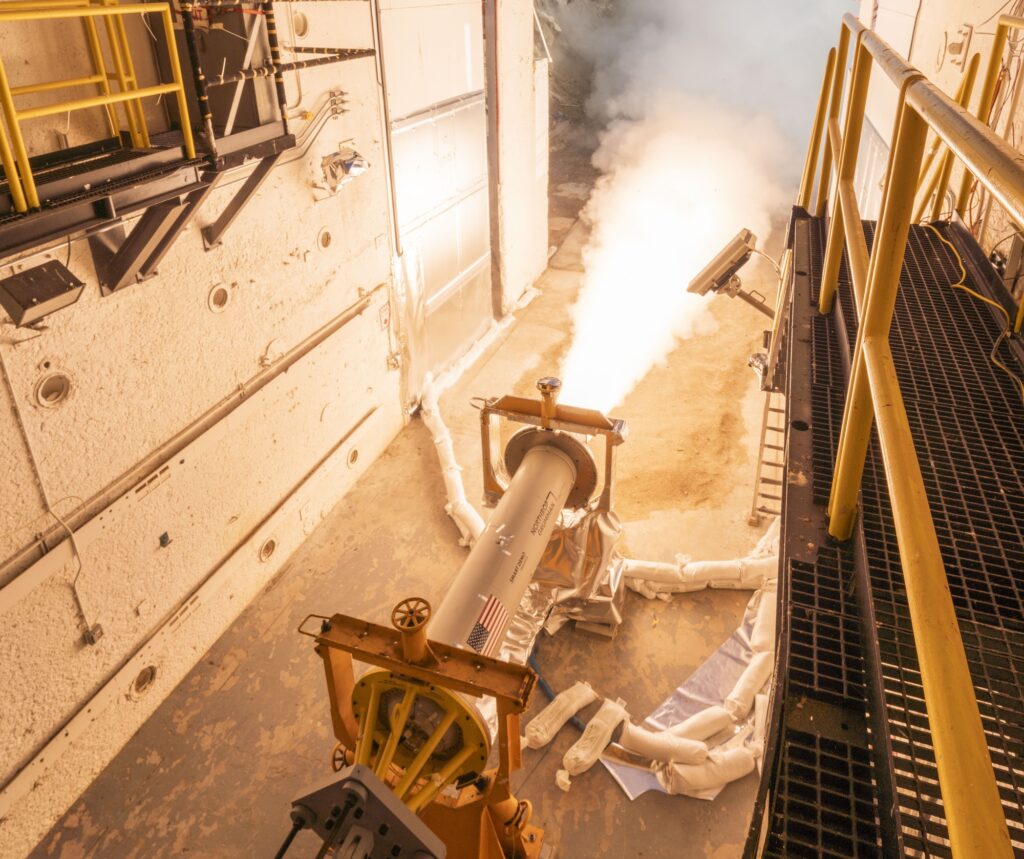Now Reading: Gabe Zimmerman on customer needs and scaling SmallSat production
-
01
Gabe Zimmerman on customer needs and scaling SmallSat production
Gabe Zimmerman on customer needs and scaling SmallSat production

This week SpaceNews is at the SmallSat Conference in Salt Lake City, Utah. In this episode of Space Minds, host Mike Gruss speaks with Gabe Zimmerman, Director, In-Space at Ursa Major.
The conversation revolves around the small satellite industry’s evolving priorities, from balancing cost and reliability to overcoming persistent supply chain challenges.
Zimmerman highlights the growing emphasis on volume production, strategic vertical integration, and early cross-team collaboration to meet rising demand for satellite hardware. Zimmerman also reflects on the conference’s growth, the rapid proliferation of small satellites, and the potential of hybrid propulsion solutions in shaping the sector’s future.
American-made. Umbra-rated. Delivered faster. Umbra is reshaping what’s possible in and through space — one component, satellite, and image at a time. We design, build, and operate the most capable radar constellation in the market, delivering unmatched access, clarity, and resilience for critical missions. Operating at every layer — from sensors to spacecraft to software — we accelerate innovation and operational advantage for those who can’t aIord to wait. Now, through our new Space Systems line, we oIer the same trusted, flight-proven hardware we use ourselves — engineered for power, precision,resilience, and control. Built to endure. Designed to deliver. Umbra puts control where it matters most.
Show notes and transcript
Click here for Notes and Transcript
Time Markers
00:00 – Episode introduction
00:55 – Welcome
01:30 – On trends
02:28 – A shift
03:01- On the supply chain
04:53 – Promise vs reality
06:57 – An evolving market
08:35 – Responding to changing demand
09:30 – What surprised you this year?
11:07 – What aren’t we talking about in the SmallSat community?
12:06 – What is a SmallSat?
Transcript – Gabe Zimmerman Conversation
Mike Gruss – Hello. I’m Mike Gruss from SpaceNews. And welcome to our Space Minds podcast from SmallSat. Today, I’m joined by Gabe Zimmerman from Ursa Major, and he is the director of the In-Space product line.
We have a team of reporters here in Salt Lake City at SmallSat, and we’ve been listening for a few topics, as I think some of our listeners know we’re talking about reliability versus cost. We’re listening to hear about launch and launch alternatives for small satellites, and we’re talking about supply chain questions. So Gabe, let’s, let’s start there, when you’re working at the booth, when you’re having meetings, when you’re talking to folks, what are some of the issues that are, that are coming up? What are some of the trends that you’re noticing?
Gabe Zimmerman – Yeah, it’s great, great question. Yeah, as far as trends we’re noticing as when it comes to reliability and cost, we’re really hearing like people want their satellites to work, they want their hardware to work, they want to be able to depend on it, and so it’s kind of at the forefront of everything we do. And you’re worried about cost, but shaving off a couple of dollars, but risking emission is generally a trade that’s kind of hard to do. That scale shifting a little bit, yeah. So you kind of want to have your cake and eat it too, but, but at the end of the day, right? I think reliability is going to win out. And so at Ursa Major, we’ve had seven successful flights. We’ve got a culture of kind of testing often and early hardware leading. And so you know, when you have hardware on the floor, when we see it from other booths, when we have it at our booth, I think it really starts to communicate to our customers and to our competitor mates, that, hey, this is like, this is real stuff.
Mike Gruss – So yeah, and how is that shift? Is that a newer thing that folks have said, Hey, we, you know, we’re willing to spend a little bit more if we can get X amount of time.
Gabe Zimmerman – I Yeah, I think it’s, I don’t know if it’s a shift. I think there’s always been a balance, right? So maybe with some of the new additive manufacturing methods or other kind of technologies, there’s some ability to pull hardware to the left and kind of see that more. But I think really it’s about putting stuff in people’s hands and showing them the value you’re adding. And that really is what does the communicating more than any single or immediate thing.
Mike Gruss – So how about on supply chain? What are you what are you hearing there?
Gabe Zimmerman – Yeah, I think, I think supply chain is really a topic of constant discussion. We’re talking about it. Our customers are talking about the government’s talking about it, really, I think there’s been a push for proliferation and more hardware, and hardware faster and being able to turn that over and really treating it more of a production, rather than every satellite being bespoke. And so, yeah, I think supply chain for us is, is at the forefront of along with design, really what we’re talking a lot about. And happy to give more examples if…
Mike Gruss – Yeah, let’s Well, let’s talk about that from Sure. And so what is the the issue is that that a lot of folks just aren’t, don’t have the materials that they need to, to follow the cadence that they want. So what? What’s the solution?
Gabe Zimmerman – Right? Yes. So I think for a lot of people, right, there’s, there’s a there’s a long wait list. You know, effectively, the lead time is long because a lot of people are buying stuff. So just start off, the demand is there, right? And so if you don’t have your production equipment and processes set up, you just can’t respond as quickly. So that’s like, I think one big thing, and then the other thing is really just kind of shape the industry to say, hey, we understand there are mission level requirements. There’s capabilities you want to have, but how do we align requirements to match hardware capabilities and meet in the middle? Because if everything is just a one off or brand new, you’re going to have a hard time closing that gap, because you’re going to not be able going to not be able to leverage as much of the hardware, the development, the testing.
So for Ursa, we’ve done, I would say strategic vertical vertical integration. So there’s kind of vertical integration evangelists who say everything has got to be us. We’re a lot more we know what. We’re really good at, propulsion, certain manufacturing methods. We want to bring those on site, but also work with partners, work with suppliers to leverage their expertise. And I think that’s how you build a more robust supply chain, not just by trying to gobble it up.
Mike Gruss – So, yeah, when, when you’re on the floor, I think one thing I’ve noticed is there’s a ton of ideas there, right? There’s a ton of, there are a ton of folks who have projects that maybe we haven’t seen before, or seen at this scale before. But what do you think is kind of the gap right now between the promise that a lot of them offer and the reality of working and operating space?
Gabe Zimmerman – Yeah, I think the you know, when you talk about, you know, maybe more early novel technologies, and kind of, like, proven reliable, or where that gap is, I think it, to me, comes down to two fold one. It’s, it’s kind of like, have you really proven it in a, in a at a scale, or, like, a number of units, right, doing something one time in a lab environment? Versus kind of covering the complexity and the environments that you regular, you have to get to space, and then you have to survive space, and there’s radiation and all that other stuff, right?
So have you done enough legwork and done all that legwork with quantity and with development and iterations to prove that? And then the second one, from kind of closing that gap, I think, is really developing, like CO developing processes with designs, right? So you can make one thing work, but making 100 of the same thing work, and so spending the calories, building the team to do those in parallel, because I think the one plague, and you know, I would say I’m a bit guilty of it, is if you spend too much time not thinking about that early, it’s hard to undo some of those design decisions. So really, just leaning into that, and I think that’s an example of where the in space team that we have is engineers, it’s manufacturing, it’s operations, it’s technicians, all co located, procurement, right? And so they’re, we’re having conversations at the onset of a design about those things. So hopefully we’re not, I mean, we’ll, we’ll get some surprises, but hopefully there’s nothing we can’t recover from, because we’re all engaged and aligned early, versus forgetting about those and then having to be like, oh, you know, how do I What do I do now?
Mike Gruss – Yeah, is there anything that maybe you’ve changed your mind on even this week or particularly the last year or two, where you’ve thought maybe differently on a topic related to space and maybe small satellites that, what is that?
Gabe Zimmerman – Yeah, I think, you know, first time I came to SmallSat was last year, but very different environment, different environment. But I’ve kind of been circling around satellites and space and aerospace for quite a while now. I think what’s been really interesting to see is just how much more, how many more satellites are being launched, how much more proliferation and kind of shorter mission lives. But more hardware is really becoming a bit more of the norm, and what we’re hearing from our customers and the government organizations and even some of our, you know, the other folks making hardware, right? It’s all about getting more stuff up there, better better coverage, you know, more capabilities, more like benefits to everyday civilians and so forth. So to me, I really think what I’m starting to see more and more of is that that push towards volume and production, and that the technology, a lot of it exists, but you can’t make a lot of them, and so the gap is almost more there.
Mike Gruss – Supply chain talked about even more important, right?
Gabe Zimmerman – It ties back in a bit of a dangerous way where you really have to have that solved, because that’s what people are asking for. Yeah. And you know, we’ve we see a lot of companies starting to launch more and more stuff, and you see these constellations, these constellations starting to come up. And so that’s kind of to me, I forget what the term not a canary in the coal mine, but a representation that that is where we’re going, at least for some technologies.
Mike Gruss – And so what does that proliferation look like? Then? Does it mean, hey, if we’re not doing something at 25,50, 100 that it’s not, it’s not worth trying or not. There might not be a business case that closes for it. Or how does that yeah, how does that kind of play out?
Gabe Zimmerman – Yeah, I think it’s not. Yeah. When it’s not, it’s not that you need to hit some target. I don’t think there’s a line where, if you’re below it or above it, there’s some break. I think it’s more just responding to the demands and what people are asking for and what they’re needing, and also being able to surge your your supply to meet that demand. And so to us, it’s like hardware on the shelf. It’s being responsive. It’s being receptive as being a partner, a collaborator, more than it is like there’s not a business case. I think it’s more just, yeah, yeah, being prepared, kind of being a member of the ecosystem, rather than, you know, onesie twosie.
Mike Gruss – So you said you were at SmallSat last year. What surprised you this this year so far? Floor or in conversations?
Gabe Zimmerman – Yeah, I think like, there’s obviously some differences, but functionally, it feels a little denser, right? Because, you know, when you were on us use campus, it’s a bit more spread out, and now we’ve kind of got this density in the more traditional conference hall, but functionally, I feel there’s a lot of the same. It’s the same great people and networking. It’s the same amazing technology, and we’re really just seeing this mature as a conference and grow as a conference as it kind of mirrors what the industry is doing.
Mike Gruss – Yeah, that’s gonna say. What does that mean?
Gabe Zimmerman – Yeah, to me, I mean to me, I think it’s, I think there’s some sentimental feelings about Logan, and it was an awesome vibe and but I think if in 1987 when the first conference occurred with 50 to 100 people. They knew where we’d be today. You know, roughly 38 years later, I think I would hope that they’re like this is exceeding our wildest dreams, as far as, right, SmallSats, whatever that means, is like this whole new burgeon. I mean, not burgeoning, it’s exploding, right? The curve is exponential. The growth is exponential. And to me, it’s like fulfilling. I’d hope, kind of what their vision was about, how, how, like, what a satellite is, is can be different. So to me, I think it’s like, it’s awesome, and it’s like, exciting to be a part of it, and here, communicating, collaborating and kind of being part of that growth.
Mike Gruss – I was part of a conversation last night, and someone said they were at SmallSat when there were 600 people, in the conversation then was, I can’t imagine it can get much bigger, but obviously, very different. What do you think is is not being talked about enough in the SmallSat community right now?
Gabe Zimmerman – That’s it. That’s a good question. I think one, one thing that comes to mind, at least from my perspective, would be kind of more cutting edge propulsion solutions. So there’s a lot of benefits to chemical and there’s a lot of benefits to electric, but how do those kind of blend and mesh? And is like, how do you enable maybe the best of both worlds? And so I think that’s one thing where there’s been some conversations, but it would be interesting to see how that evolves. Some people call it multi mode or other things, but I think, yeah, generally, there’s just a lot of everyone’s kind of working a lot of cool problems. So it’s hard for me to even pinpoint one real big missing piece of the puzzle. And sometimes you don’t know what’s missing till it’s there. And you’re like, oh, there it is.
Mike Gruss – Right. Last question, this is kind of a fun one, what, what what is and what is not, a SmallSat, like, how do you how do you know that? Yeah, this isn’t and this is?
Gabe Zimmerman – I don’t feel fully qualified to draw that box or that line, but in the vein of of capacity and volume and proliferation. To me, like not that you can’t make a lot of big things, but generally, making big things is harder. There’s more manufacturing complexity stuff. So maybe I would try to think less about a volume or a mass and more about an ability to mass produce, and the the benefits you get from that mass production and and maybe, maybe that’s really where the line is, right, because now you can make CubeSats cheaply, and as besides, is getting more popular and as per grant, right? So maybe those are actually all kind of going to fall nicely in that niche, and it’s only the mega, big satellites that wouldn’t get to be categorized there. So…
Mike Gruss – Great. Well, Gabe, thanks so much for joining us. I really appreciate it. I’d like to thank our sponsor, Umbra, who’s been helping us with these podcasts. This week, all of our coverage from SmallSat is available on space news.com our August issue is on the newsstand, and we also have our show dailies this week available throughout the convention center and at our booth, thanks so much for watching.
About Space Minds
Space Minds is a new audio and video podcast from SpaceNews that focuses on the inspiring leaders, technologies and exciting opportunities in space.
The weekly podcast features compelling interviews with scientists, founders and experts who love to talk about space, covers the news that has enthusiasts daydreaming, and engages with listeners. Join David Ariosto, Mike Gruss and journalists from the SpaceNews team for new episodes every Thursday.
Watch a new episode every Thursday on SpaceNews.com and on our YouTube, Spotify and Apple channels.
Be the first to know when new episodes drop! Enter your email, and we’ll make sure you get exclusive access to each episode as soon as it goes live!
Space Minds Podcast
“*” indicates required fields
Note: By registering, you consent to receive communications from SpaceNews and our partners.
Stay Informed With the Latest & Most Important News
-
 012024 in Review: Highlights from NASA in Silicon Valley
012024 in Review: Highlights from NASA in Silicon Valley -
 02Panasonic Leica Summilux DG 15mm f/1.7 ASPH review
02Panasonic Leica Summilux DG 15mm f/1.7 ASPH review -
 03How New NASA, India Earth Satellite NISAR Will See Earth
03How New NASA, India Earth Satellite NISAR Will See Earth -
 04And Thus Begins A New Year For Life On Earth
04And Thus Begins A New Year For Life On Earth -
 05Astronomy Activation Ambassadors: A New Era
05Astronomy Activation Ambassadors: A New Era -
06SpaceX launch surge helps set new global launch record in 2024
-
 07From Polymerization-Enabled Folding and Assembly to Chemical Evolution: Key Processes for Emergence of Functional Polymers in the Origin of Life
07From Polymerization-Enabled Folding and Assembly to Chemical Evolution: Key Processes for Emergence of Functional Polymers in the Origin of Life




















